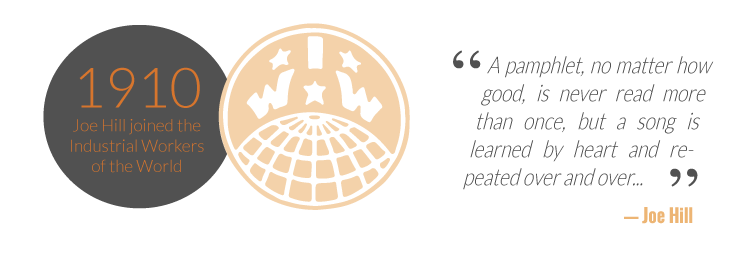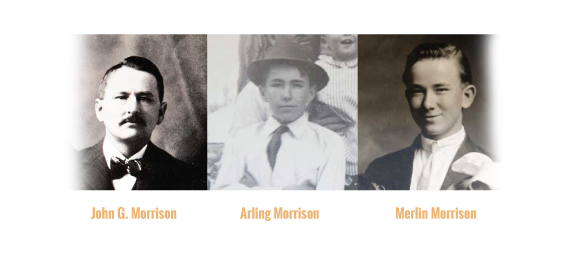1902
Joel Hägglund, who later used the names Joseph Hillstrom and Joe Hill, left Sweden and settled in the United States.
FEB. 2, 1903
John G. Morrison was confronted by armed men in masks at his first grocery store, at 470 S. 100 West (today's 200 West). He was slightly injured and wounded one of the men in an exchange of gunfire.
JAN. 22, 1906
John G. Morrison joined the Salt Lake City Police Department as the American Party took control of city government.
APRIL 1, 1907 John G. Morrison resigned from the Salt Lake City Police Department.
APRIL 1, 1907 John G. Morrison resigned from the Salt Lake City Police Department.
APPRX. 1907
John G. Morrison opened a new grocery store at 778 S. West Temple.
1910
By 1910, Joe Hill had joined the Industrial Workers of the World, using the number of the Portland, Ore., local in his writing.
More about the IWW
More about the IWW
1911
 The Industrial Workers of the World first published one of Joe Hill's songs, "The Preacher and the Slave," in its "Little Red Songbook."
The Industrial Workers of the World first published one of Joe Hill's songs, "The Preacher and the Slave," in its "Little Red Songbook."
 The Industrial Workers of the World first published one of Joe Hill's songs, "The Preacher and the Slave," in its "Little Red Songbook."
The Industrial Workers of the World first published one of Joe Hill's songs, "The Preacher and the Slave," in its "Little Red Songbook."
AUG. 12, 1913
The Industrial Workers of the World held a rally in in downtown Salt Lake City to celebrate a successful strike against the Utah Construction Company on a railroad project in Spanish Fork Canyon. But a man who had helped arrest union members in the canyon led an attack on the crowd and a riot broke out.
SEPT. 20, 1913
John G. Morrison was walking home from his grocery store with the day's receipts when two armed robbers confronted him. The men fired at Morrison, who was carrying a gun and fired back, and they fled.
FALL 1913
Joe Hill and his friend, Otto Appelquist, arrived in Utah. At times, they stayed in the home of the Eselius brothers; the men met while all four were working on the waterfront in San Pedro, Calif.
CHRISTMAS EVE, 1913
At a party, Otto Appelquist was introduced as the fiancé of Hilda Erickson, a cousin of the Eselius brothers. Years later, Erickson wrote a letter saying she soon broke off the engagement.
JAN. 10, 1914
Just after 9:45 p.m., two men with red bandanas over their noses and chins burst into John Morrison's grocery store at 778 S. West Temple. "We've got you now!" one cried, and immediately shot John Morrison. His son Arling grabbed a gun; prosecutors later contended Arling fired and struck one assailant before he was shot three times and fell dead. The killers fled.
Read a detailed timeline of the night here.
Read a detailed timeline of the night here.
JAN. 10, 1914
Around 11:30 p.m., itinerant laborer and Industrial Workers of the World union member Joe Hill appeared at the home office of physician Frank M. McHugh with a gunshot wound to his chest. McHugh's office was at State Street and 1400 South, which is 3900 South on today's street grid
See a map
See a map
JAN. 11, 1914
Around 1 a.m., a doctor who had dropped by physician Frank M. McHugh's office drove Joe Hill to the Eselius brothers' home. Hill spoke privately with his friend Otto Appelquist, who had also been staying with the family.
AROUND 2 a.m.
 Otto Appelquist announced he was leaving the Eselius house to find work — and vanished. Police searches were fruitless, and there are scant records about the rest of his life.
Otto Appelquist announced he was leaving the Eselius house to find work — and vanished. Police searches were fruitless, and there are scant records about the rest of his life.
 Otto Appelquist announced he was leaving the Eselius house to find work — and vanished. Police searches were fruitless, and there are scant records about the rest of his life.
Otto Appelquist announced he was leaving the Eselius house to find work — and vanished. Police searches were fruitless, and there are scant records about the rest of his life.
TUESDAY, JAN. 13, 1914
After learning of the Morrison murders, one or both of the doctors who had treated Joe Hill tipped police to his gunshot wound. Hill was arrested at the Eselius home on Tuesday and taken to jail.
JAN. 28, 1914
Joe Hill represented himself at a preliminary hearing and was ordered to stand trial for first-degree murder.
JUNE 10 TO 27, 1914 Joe Hill was tried for first-degree murder. The jury found him guilty on June 27, 1914.
JUNE 10 TO 27, 1914 Joe Hill was tried for first-degree murder. The jury found him guilty on June 27, 1914.
JULY 8, 1914
At his sentencing, Joe Hill chose the firing squad over hanging. His execution was set for Sept. 4, 1914, but it was stayed when his appeal was filed with the Utah Supreme Court.
MAY 28, 1915
The Utah Supreme Court heard arguments in Joe Hill's appeal.
JULY 3, 1915 Joe Hill's appeal was rejected by the Utah Supreme Court and his conviction was upheld. At a new sentencing on Aug. 2, 1915, a new execution date was set: Oct. 1, 1915.
JULY 3, 1915 Joe Hill's appeal was rejected by the Utah Supreme Court and his conviction was upheld. At a new sentencing on Aug. 2, 1915, a new execution date was set: Oct. 1, 1915.
SEPT. 18, 1915
Joe Hill's attorneys asked Utah's Board of Pardons to commute Hill's death sentence. The board asked Hill to explain his wound, or provide other evidence that would show his innocence. Hill repeatedly asked the board for a new trial, which members explained they did not have the authority to grant. The board denied the commutation request.
SEPT. 30, 1915
With hours to go before Joe Hill's scheduled Oct. 1 execution, President Woodrow Wilson sent a telegram to Utah Gov. William Spry, asking for a postponement so the Swedish minister could have time to examine the case. Spry reluctantly agreed and the execution was rescheduled for Oct. 16, 1915.
OCT. 16, 1915
The Utah Board of Pardons again ruled against Joe Hill. He returned to court on Oct. 18 for another sentencing and was sentenced to die on Nov. 19, 1915.
NOV. 17, 1915
President Woodrow Wilson again asked Utah Gov. William Spry to stay Joe Hill's execution. After the Utah Board of Pardons held an emergency meeting the next day, Spry rebuffed Wilson's second request.
NOV. 19, 1915
Joe Hill was executed by a firing squad at the Utah state prison in what is today Sugar House Park. The Salt Lake Herald-Republican reported his last words as: "Let it go, fire!"







